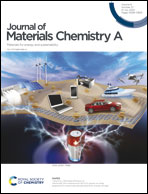Isovalent doping: a new strategy to suppress surface Sr segregation of the perovskite O2-electrode for solid oxide fuel cells†
Abstract
Surface Sr segregation and phase separation are the key reasons behind the chemical instability of Sr-containing perovskite oxide surfaces and the corresponding performance degradation of solid oxide fuel cell O2-electrodes, but to date, practical solutions to prevent this phenomenon are limited. Here, we investigate how isovalent doping (in this case, Zr substitution of Ti) changes the surface morphology, chemical composition, and thus the O2 activation kinetics under actual operating conditions. Thin films of SrTi0.5Fe0.5O3−δ as a representative model perovskite O2-electrode, with Zr doping, are fabricated via pulsed laser deposition and their surface oxygen exchange rates are then characterized via electrical conductivity relaxation assessments. Zr dopants strengthen the Sr–O bonds in the oxide lattice, inhibiting the formation of surface SrOx clusters and significantly reducing the deterioration of the oxygen exchange rates compared to the results from undoped film at 650 °C for 30 h. These observations suggest a new strategy for ensuring the surface stability of Sr-containing perovskite oxides for fuel cell O2-electrodes.



 Please wait while we load your content...
Please wait while we load your content...